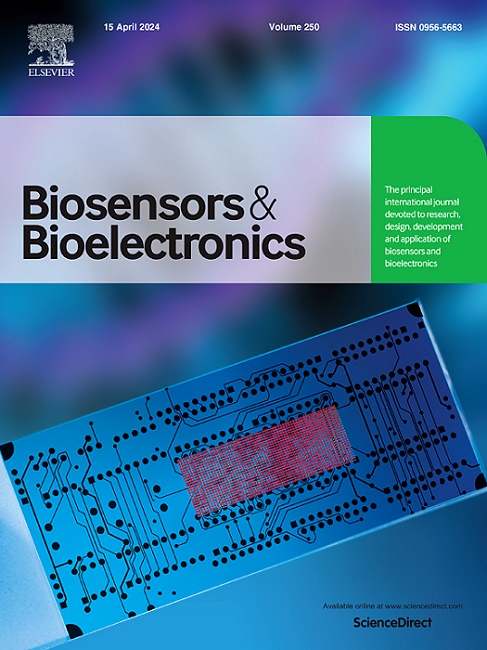鞣花酸嵌入MoO3纳米线结构:炎症性肠病标志物的无外源性介质电化学免疫探测
IF 10.5
1区 生物学
Q1 BIOPHYSICS
引用次数: 0
摘要
氧化应激生物标志物如8-iso-前列腺素F2α (8-iso-PGF2α)决定了临床流行(非)传染性疾病如炎症性肠病(IBD)的中心规律,但由于传统检测方法的复杂性、敏感性和选择性,研究较少。因此,迫切需要一种快速、简单、可靠的方法来检测8-iso-PGF2α。本文采用连接物化学介导的鞣花酸嵌入MoO3 NWs结构作为无外部介质的传感器,开发了8-iso-PGF2α生物传感器。优化后的生物传感器在较宽的分析范围(0.5 - 5000pg /mL)和LOD ~ 0.28 pg/mL具有良好的重现性(RSD 2.0%),具有稳健和判别性。8-iso-PGF2α生物传感器在IBD患者临床样品检测方面的实用性得到了证明,并使用混合- altman技术与ELISA交叉验证,建立了强相关性,可忽略的偏差和方差系数(X ~ = 6.88%),具有用户友好和快速分析响应(~ 60 s)的额外优势。因此,提出的生物传感器是一种可靠的POC筛选工具,能够预测疾病的发病,监测进展,并评估大型纵向队列和临床景观的治疗效果。本文章由计算机程序翻译,如有差异,请以英文原文为准。

Ellagic acid-imbedded MoO3 nanowires architecture: External mediator-less electrochemical immunoprobing of inflammatory bowel disease marker
Oxidative stress biomarkers such as 8-iso-prostaglandin F2α (8-iso-PGF2α) dictate a central dogma of clinically prevalent (non) communicable diseases such as inflammatory bowel disease (IBD) but are less explored owing to the complexity, sensitivity, and selectivity of conventional detecting methods. Thus, there is an urgent need for a rapid, simple, and reliable method for point-of-care (POC) detection of 8-iso-PGF2α. Herein, linker chemistry mediated ellagic acid imbedded MoO3 NWs architecture is employed as an external mediator-free transducer to develop an 8-iso-PGF2α biosensor. The optimized biosensor provided robust and discriminative analytical performance for a wide range (0.5–5000 pg/mL) and LOD∼0.28 pg/mL with good reproducibility (RSD 2.0 %). The 8-iso-PGF2α biosensor's practicality towards clinical sample detection collected from IBD patients is demonstrated and cross-validated against the ELISA using the Blend-Altman technique, establishing a strong correlation, negligible bias and coefficient of variance ( = 6.88 %) with the added advantage of user-friendliness and fast analytical response (∼60 s). Thus, the proposed biosensor is a reliable POC screening tool capable of predicting disease onset, monitoring progression, and assessing treatment efficacy in large longitudinal cohorts and clinical landscapes.
求助全文
通过发布文献求助,成功后即可免费获取论文全文。
去求助
来源期刊

Biosensors and Bioelectronics
工程技术-电化学
CiteScore
20.80
自引率
7.10%
发文量
1006
审稿时长
29 days
期刊介绍:
Biosensors & Bioelectronics, along with its open access companion journal Biosensors & Bioelectronics: X, is the leading international publication in the field of biosensors and bioelectronics. It covers research, design, development, and application of biosensors, which are analytical devices incorporating biological materials with physicochemical transducers. These devices, including sensors, DNA chips, electronic noses, and lab-on-a-chip, produce digital signals proportional to specific analytes. Examples include immunosensors and enzyme-based biosensors, applied in various fields such as medicine, environmental monitoring, and food industry. The journal also focuses on molecular and supramolecular structures for enhancing device performance.
 求助内容:
求助内容: 应助结果提醒方式:
应助结果提醒方式:


